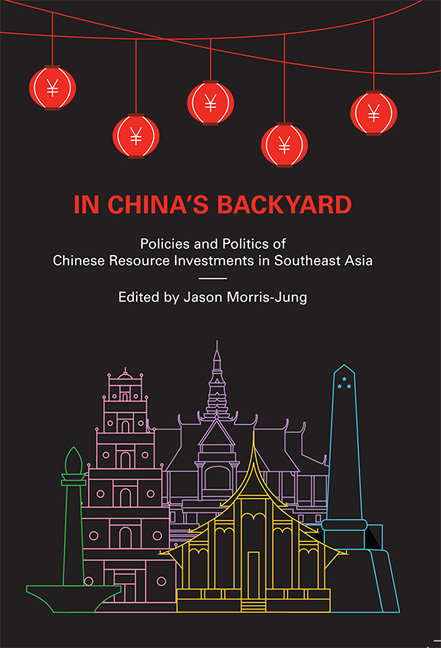Book contents
- Frontmatter
- Contents
- Foreword
- Acknowledgements
- About the Contributors
- 1 Introduction
- 2 Mixed Motivations, Mixed Blessings: Strategies and Motivations for Chinese Energy and Mineral Investments in Southeast Asia
- 3 Mineral Resources in China's “Periphery” Diplomacy
- 4 Energy Entanglement: New Directions for the China–Indonesia Coal Relationship
- 5 Indonesia–China Energy and Mineral Ties: The Rise and Fall of Resource Nationalism?
- 6 The Direction, Patterns, and Practices of Chinese Investments in Philippine Mining
- 7 Development Cooperation with Chinese Characteristics: Opium Replacement and Chinese Rubber Investments in Northern Laos
- 8 The High Cost of Effective Sovereignty: Chinese Resource Access in Cambodia
- 9 Complex Contestation of Chinese Energy and Resource Investments in Myanmar
- 10 Anti-Chinese Protest in Vietnam: Complex Conjunctures of Resource Governance, Geopolitics and State–Society Deadlock
- 11 Complexities of Chinese Involvement in Mining in the Philippines
- 12 Conclusion
- Bibliography
- Index
3 - Mineral Resources in China's “Periphery” Diplomacy
Published online by Cambridge University Press: 04 July 2018
- Frontmatter
- Contents
- Foreword
- Acknowledgements
- About the Contributors
- 1 Introduction
- 2 Mixed Motivations, Mixed Blessings: Strategies and Motivations for Chinese Energy and Mineral Investments in Southeast Asia
- 3 Mineral Resources in China's “Periphery” Diplomacy
- 4 Energy Entanglement: New Directions for the China–Indonesia Coal Relationship
- 5 Indonesia–China Energy and Mineral Ties: The Rise and Fall of Resource Nationalism?
- 6 The Direction, Patterns, and Practices of Chinese Investments in Philippine Mining
- 7 Development Cooperation with Chinese Characteristics: Opium Replacement and Chinese Rubber Investments in Northern Laos
- 8 The High Cost of Effective Sovereignty: Chinese Resource Access in Cambodia
- 9 Complex Contestation of Chinese Energy and Resource Investments in Myanmar
- 10 Anti-Chinese Protest in Vietnam: Complex Conjunctures of Resource Governance, Geopolitics and State–Society Deadlock
- 11 Complexities of Chinese Involvement in Mining in the Philippines
- 12 Conclusion
- Bibliography
- Index
Summary
This chapter analyses key challenges that China currently faces in securingsupplies of strategic mineral resources from its neighbouring or “periphery”regions. It provides some perspectives on Chinese state interests in ensuringlong-term mineral supply from its neighbouring mineral-rich countries,as well as offer policy recommendations on how China can improve onresource diplomacy in its “peripheries”. The chapter does not aim to becomprehensive in its review of these minerals, but instead surveys someimportant minerals to reflect on how Chinese strategies for sourcing mineralsfrom peripheral regions are relevant to China's mineral investments inSoutheast Asia.
Introduction
“Strategic minerals” can be defined as natural resources that are important to a state's economic development, national security or people's livelihoods. The US Geological Survey (USGS) includes additional criteria for defining “strategic minerals” as commodities that are not easily replaceable yet they are extracted mainly from foreign sources. Among industrialized nations, competition over theexploitation, production and accumulation of strategic minerals have come under international media attention.
As China's economy has been developing rapidly since economic reforms that started in 1979, its consumption and import of strategic mineral resources has also increased significantly. According to the Chinese Academy of Engineering's definition of forty-five strategic minerals, China is in short supply or cannot guarantee adequate supply of twenty-seven different kinds of strategic minerals. More than half of them are currently imported from Southeast Asia and Australia, mineral-rich regions proximate to China. Southeast Asia is also China's most important supplier for nickel, aluminum ore (i.e., bauxite) and coal. As China's demand for strategic minerals is likely to keep increasing, based on projected slowing but continuing growth, China will need to consider several important factors to ensure accurate and realistic assessments of availability and accessibility for long-term resource supplies, especially from its neighbouring regions such as Southeast Asia.
This chapter analyses the key challenges China currently faces in securing supplies of strategic mineral resources from its neighbouring or “periphery” regions (translated as “zhoubianguojia” in Chinese hanyu pinyin romanization), which refer to those countries and regions surrounding the Chinese overland borders and coastal areas. The “periphery” is a necessarily loose categorization, but it has particular significance because of the particular geopolitical and close economic relations that China shares with these countries and regions historically.
- Type
- Chapter
- Information
- In China's BackyardPolicies and Politics of Chinese Resource Investments in Southeast Asia, pp. 57 - 78Publisher: ISEAS–Yusof Ishak InstitutePrint publication year: 2017

